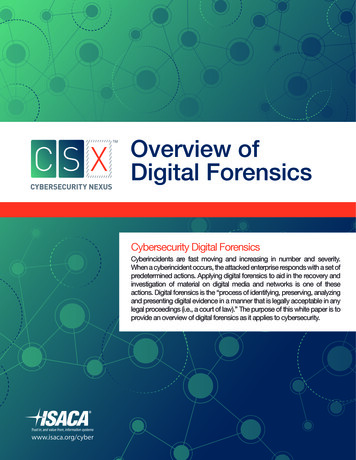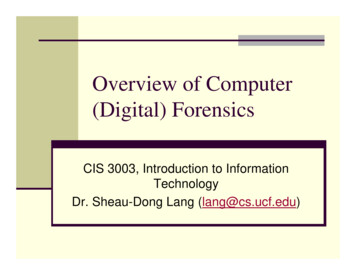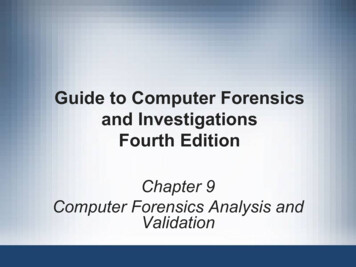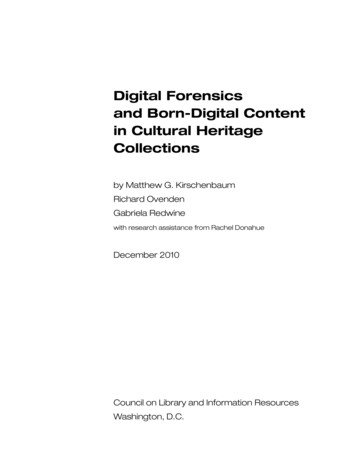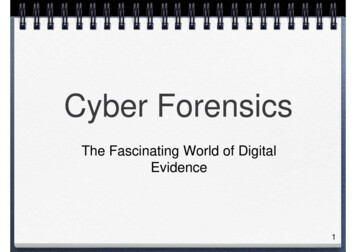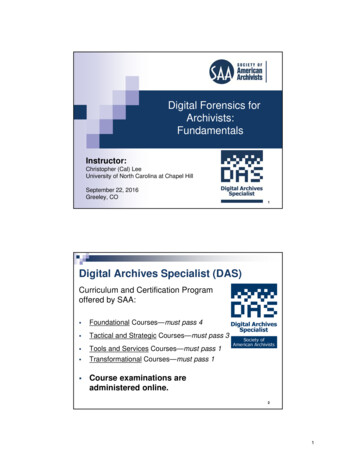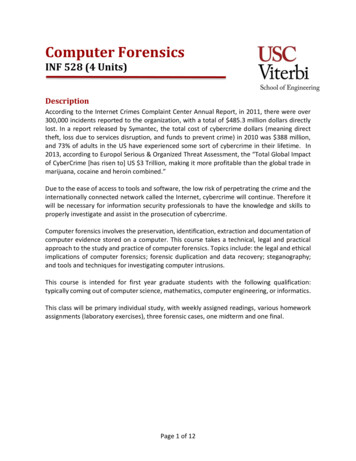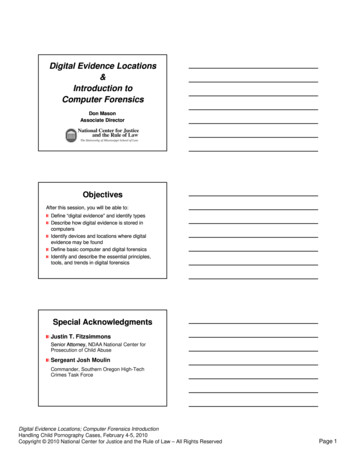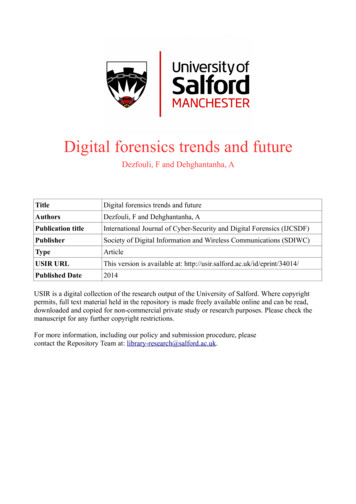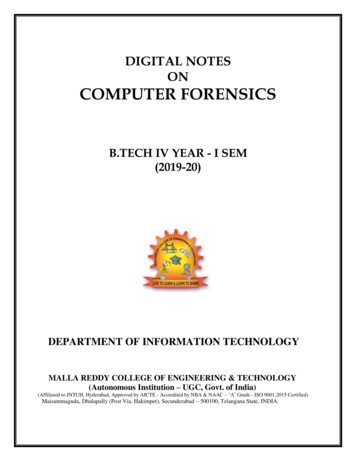
Transcription
DIGITAL NOTESONCOMPUTER FORENSICSB.TECH IV YEAR - I SEM(2019-20)DEPARTMENT OF INFORMATION TECHNOLOGYMALLA REDDY COLLEGE OF ENGINEERING & TECHNOLOGY(Autonomous Institution – UGC, Govt. of India)(Affiliated to JNTUH, Hyderabad, Approved by AICTE - Accredited by NBA & NAAC – ‘A’ Grade - ISO 9001:2015 Certified)Maisammaguda, Dhulapally (Post Via. Hakimpet), Secunderabad – 500100, Telangana State, INDIA.
MALLA REDDY COLLEGE OF ENGINEERING & TECHNOLOGYDEPARTMENT OF INFORMATION TECHNOLOGYUNIT - IComputer Forensics Fundamentals: What is Computer Forensics?,Use of ComputerForensics in Law Enforecement,Computer Forensics Assistance to HumanRecources/Employment Proceedings,Computer Forensics Services,Benefits ofprofessional Forensics Methodology,Steps taken by Computer Forensics Specialists.Types of Computer Forensics Technology: - Types of Business Computer ForensicTechnology.Types of Military Computer Forensic Technology,Types of LawEnforcement- Computer Forensic Technology,Types of Business Computer ForensicTechnology.Computer Forensics Evidence and capture: Data Recovery Defined-Data Back-up andRecovery-The Role of Back -up in Data Recovery-The Data -Recovery Solution.UNIT - IIEvidence Collection and Data Seizure: Why Collect Evidence? Collection OptionsObstacles-Types of Evidence-The Rules of Evidence-Volatile Evidence-GeneralProcedure-Collection and Archiving-Methods of Collections-Art facts-Collection Steps-Controlling Contamination: The chain of custody.Duplication and Preservation of Digital Evidence: Preserving the Digital CrimeScene-Computer Evidence processing steps-Legal Aspects of collecting and PreservingComputer forensic Evidence.Computer image Verification and Authentication: Special needs of EvidentialAuthentication - Practical Consideration-Practical Implementation.UNIT - IIIComputer forensic analysis and validation: Determining what data to collect andanalyze, validating forensic data, addressing data-hiding techniques, performing remoteacquisitionsNetwork Forensics: Network forensic overview, performing live acquisitions,developing standar procedures for network forensics, using network tools, examining thehoneynet project.Processing crime at incident scenes: Identifying digital evidence, collecting evidence inprivate-sector incident scenes, processing law enforcement crime scenes, preparing for asearch, securing a computer incident or crime scene, seizing digital evidence at the scene,storing digital evidence, obtaining a digital hash, reviewing a case.
UNIT - IVCurrent Computer Forensic Tools: evaluating computer forensic tool needs, computerforensic software tools, computer forensic hardware tools, validating and testing forensicsoftware.E-mail investigations: Exploring the role of email in investigations, exploring the role ofclient and server in email, investigating email crimes and violations, understanding emailservers, using specialized email forensic tools.Cell phone and mobile device forensics: Understanding mobile device forensic,understanding acquisition procedures for cell phones and mobile devices.UNIT - VWorking with windows and dos systems: understanding file systems, exploringMicrosoft file structures examining NTFS disks, understanding whole disk encryption,windows registry, Microsoft startup tasks, MS Dos startup tasks, virtual machines.TEXT BOOKS:1. Computer Forensics, Computer Crime Investigation by John R,Vacca, Firewall Media,New Delhi.2. Computer Forensics and Investigations by Nelson, Phillips Enfinger, Steuart, CENGAGELearning.REFERENCE BOOKS:1. Real Digital Forensics by Keith j.Jones, Richard Bejitlich,Curtis W.Rose ,AddisonWesley Pearson Education2. Forensic Compiling,A TractitionerisJenkinson,Springer International edition.GuidebyTonySammesandBrain3. Computer Evidence Collection &Presentation by Chrostopher L.T. Brown,FirewallMedia.4. Homeland Security ,Techniques& Technologies by Jesus Mena,Firewall Media.5. Software Forensics Collecting Evidence from the Scene of a Digital Crime by RobertM.Slade ,TMH 20056. Windows Forensics by chad Steel,Wiley India Edition.
MALLA REDDY COLLEGE OF ENGINEERING & TECHNOLOGYDEPARTMENT OF INFORMATION TECHNOLOGYINDEXS.NO123TOPIC NAMEUNIT-1Computer Forensics FundamentalsTypes Of Computer Forensic TechnologyComputer Forensics Evidence and capturePAGE.NO1714456UNIT-2Evidence Collection and Data SeizureDuplication and Preservation of Digital EvidenceComputer image Verification and AuthenticationUNIT-3223140789Computer forensic analysis and validationNetwork ForensicsProcessing crime at incident scenes486065101112131415UNIT-4Current Computer Forensic ToolsE-mail investigationsCell phone and mobile device forensicsUNIT-5Working with windows and dos systemsUnderstanding Whole Disk EncryptionVirtual Machines74808994105112
MRCETDEPARTMENT OF ITUNIT-1INTRODUCTION1.1 WHAT IS COMPUTER FORENSICS? Computer forensics is the process of methodically examining computer media (harddisks, diskettes, tapes, etc.) for evidence. In other words, computer forensics is thecollection, preservation, analysis, and presentation of computer-related evidence. Computer forensics also referred to as computer forensic analysis, electronic discovery,electronic evidence discovery, digital discovery, data recovery, data discovery, computeranalysis, and computer examination. Computer evidence can be useful in criminal cases, civil disputes, and human resources/employment proceedings.1.2 USE OF COMPUTER FORENSICS IN LAW ENFORCEMENTComputer forensics assists in Law Enforcement. This can include: Recovering deleted files such as documents, graphics, and photos. Searching unallocated space on the hard drive, places where an abundance of data oftenresides. Tracing artifacts, those tidbits of data left behind by the operating system. Our expertsknow how to find these artifacts and, more importantly, they know how to evaluate thevalue of the information they find. Processing hidden files — files that are not visible or accessible to the user — that containpast usage information. Often, this process requires reconstructing and analyzing the datecodes for each file and determining when each file was created, last modified, last accessedand when deleted. Running a string-search for e-mail, when no e-mail client is obvious.COMPUTER FORENSICSPage 1
MRCETDEPARTMENT OF IT1.3 COMPUTER FORENSICS ASSISTANCE TO HUMAN RESOURCES /EMPLOYMENT PROCEEDINGSComputers can contain evidence in many types of human resources proceedings, includingsexual harassment suits, allegations of discrimination, and wrongful termination claims.Evidence can be found in electronic mail systems, on network servers, and on individualemployee’s computers.EMPLOYER SAFEGUARD PROGRAMEmployers must safeguard critical business information. An unfortunate concern today is thepossibility that data could be damaged, destroyed, or misappropriated by a discontentedindividual. Before an individual is informed of their termination, a computer forensic specialistshould come on-site and create an exact duplicate of the data on the individual’s computer. Inthis way, should the employee choose to do anything to that data before leaving, the employeris protected. Damaged or deleted data can be re-placed, and evidence can be recovered to showwhat occurred. This method can also be used to bolster an employer’s case by showing theremoval of proprietary information or to protect the employer from false charges made by theemployee. You should be equipped to find and interpret the clues that have been left behind.This includes situations where files have been deleted, disks have been reformatted, or othersteps have been taken to conceal or destroy the evidence. For example, did you know? What Web sites have been visited? What files have been downloaded? When files were last accessed? Of attempts to conceal or destroy evidence? Of attempts to fabricate evidence? That the electronic copy of a document can contain text that was removed from the finalprinted version? That some fax machines can contain exact duplicates of the last several hundred pagesreceived?COMPUTER FORENSICSPage 2
MRCETDEPARTMENT OF IT That faxes sent or received via computer may remain on the computer indefinitely? That email is rapidly becoming the communications medium of choice for businesses? That people tend to write things in email that they would never consider writing in amemorandum or letter? That email has been used successfully in criminal cases as well as in civil litigation? That email is often backed up on tapes that are generally kept for months or years? That many people keep their financial records, including investments, on computers?1.4 COMPUTER FORENSICS SERVICESComputer forensics professionals should be able to successfully perform complex evidencerecovery procedures with the skill and expertise that lends credibility to your case.For example, they should be able to perform the following services:1. DATA SEIZURE Following federalguidelines, computer forensics experts should act as therepresentative, using their knowledge of data storage technologies to track downevidence. The experts should also be able to assist officials during the equipment seizure process.2. DATA DUPLICATION/PRESERVATION When one party must seize data from another, two concerns must be addressed: the data must not be altered in any way the seizure must not put an undue burden on the responding party The computer forensics experts should acknowledge both of these concerns by makingan exact duplicate of the needed data. When experts works on the duplicate data, the integrity of the original is maintained.3. DATA RECOVERY Using proprietary tools, your computer forensics experts should be able to safely recoverCOMPUTER FORENSICSPage 3
MRCETDEPARTMENT OF ITand analyze otherwise inaccessible evidence. The ability to recover lost evidence is made possible by the expert’s advancedunderstanding of storage technologies.4. DOCUMENT SEARCHES Computer forensics experts should also be able to search over 200,000 electronicdocuments in seconds rather than hours. The speed and efficiency of these searches make the discovery process less complicatedand less intrusive to all parties involved.5. MEDIA CONVERSION Computer forensics experts should extract the relevant data from old and un-readabledevices, convert it into readable formats, and place it onto new storage media foranalysis.6. EXPERT WITNESS SERVICES Computer forensics experts should be able to explain complex technical processes in aneasy-to- understand fashion. This should help judges and juries comprehend how computer evidence is found, what itconsists of, and how it is relevant to a specific situation.7. COMPUTER EVIDENCE SERVICE OPTIONSComputer forensics experts should offer various levels of service, each designed to suit yourindividual investigative needs. For example, they should be able to offer the followingservices: Standard service: Computer forensics experts should be able to work on your caseduring nor-mal business hours until your critical electronic evidence is found. On-site service: Computer forensics experts should be able to travel to your location toCOMPUTER FORENSICSPage 4
MRCETDEPARTMENT OF ITper-form complete computer evidence services. While on-site, the experts shouldquickly be able to produce exact duplicates of the data storage media in question. Emergency service: Your computer forensics experts should be able to give your casethe highest priority in their laboratories. They should be able to work on it withoutinterruption until your evidence objectives are met. Priority service: Dedicated computer forensics experts should be able to work on yourcase during normal business hours (8:00 A.M. to 5:00 P.M., Monday through Friday)until the evidence is found. Priority service typically cuts your turnaround time in half. Weekend service: Computer forensics experts should be able to work from 8:00 A.M.to 5:00 P.M., Saturday and Sunday, to locate the needed electronic evidence and willcontinue 14 Computer Forensics, Second Edition working on your case until yourevidence objectives are met.8. OTHER MISCELLANEOUS SERVICESComputer forensics experts should also be able to provide extended services. These servicesinclude: Analysis of computers and data in criminal investigations On-site seizure of computer data in criminal investigations Analysis of computers and data in civil litigation. On-site seizure of computer data in civil litigation Analysis of company computers to determine employee activity Assistance in preparing electronic discovery requests Reporting in a comprehensive and readily understandable manner Court-recognized computer expert witness testimony Computer forensics on both PC and Mac platforms Fast turnaround time.COMPUTER FORENSICSPage 5
MRCETDEPARTMENT OF IT1.5 BENEFITS OF PROFESSIONAL FORENSIC METHODOLOGYA knowledgeable computer forensics professional should ensure that a subject computersystem is carefully handled to ensure that:1.No possible evidence is damaged, destroyed, or otherwise compromised by theprocedures used to investigate the computer.2.No possible computer virus is introduced to a subject computer during the analysis process.3.Extracted and possibly relevant evidence is properly handled and protected from latermechanical or electromagnetic damage.4.A continuing chain of custody is established and maintained.5.Business operations are affected for a limited amount of time, if at all.6.Any client-attorney information that is inadvertently acquired during a forensicexploration is ethically and legally respected and not divulged.1.6 STEPS TAKEN BY COMPUTER FORENSICS SPECIALISTSThe computer forensics specialist should take several careful steps to identify and attempt toretrieve possible evidence that may exist on a subject’s computer system. For example, thefollowing steps should be taken:1. Protect the subject computer system during the forensic examination from any possiblealteration, damage, data corruption, or virus introduction.2. Discover all files on the subject system. This includes existing normal files, deleted yetremaining files, hidden files, password-protected files, and encrypted files.3. Recover all of discovered deleted files.4. Reveal the contents of hidden files as well as temporary or swap files used by both theapplication programs and the operating system.5. Access the contents of protected or encrypted files.6. Analyze all possibly relevant data found in special areas of a disk. This includes but isnot limited to what is called unallocated space on a disk, as well as slack space in a fileCOMPUTER FORENSICSPage 6
MRCETDEPARTMENT OF IT(the remnant area at the end of a file in the last assigned disk cluster, that is unused bycurrent file data, but once again, may be a possible site for previously created andrelevant evidence).7. Print out an overall analysis of the subject computer system, as well as a listing of allpossibly relevant files and discovered file data.8. Provide an opinion of the system layout; the file structures discovered; any discovereddata and authorship information; any attempts to hide, delete, protect, and encryptinformation; and anything else that has been discovered and appears to be relevant to theoverall computer system examination.9. Provide expert consultation and/or testimony, as required.TYPES OF COMPUTER FORENSIC TECHNOLOGY1.7 TYPES OF MILITARY COMPUTER FORENSIC TECHNOLOGY Key objectives of cyber forensics include rapid discovery of evidence, estimation ofpotential impact of the malicious activity on the victim, and assessment of the intent andidentity of the perpetrator. Real-time tracking of potentially malicious activity is especially difficult when thepertinent information has been intentionally hidden, destroyed, or modified in order toelude discovery. National Law Enforcement and Corrections Technology Center (NLECTC) works withcriminal justice professionals to identify urgent and emerging technology needs. NLECTC centers demonstrate new technologies, test commercially availabletechnologies and publish results — linking research and practice. National Institute of Justice (NIJ) sponsors research and development or identifies bestpractices to address those needs. The information directorate entered into a partnership with the NIJ via the auspices ofthe NLECTC, to test the new ideas and prototype tools. The Computer ForensicsExperiment 2000 (CFX-2000) resulted from this partnership.COMPUTER FORENSICSPage 7
MRCETDEPARTMENT OF ITCOMPUTER FORENSIC EXPERIMENT-2000 (CFX-2000) CFX-2000 is an integrated forensic analysis framework. The central hypothesis of CFX-2000 is that it is possible to accurately determine themotives, intent, targets, sophistication, identity, and location of cyber criminals andcyber terrorists by deploying an integrated forensic analysis framework. The cyber forensic tools involved in CFX-2000 consisted of commercial off-the-shelfsoftware and directorate-sponsored R&D prototypes. CFX includes SI-FI integrationenvironment. The Synthesizing Information from Forensic Investigations (SI-FI) integrationenvironment supports the collection, examination, and analysis processes employedduring a cyber-forensic investigation. The SI-FI prototype uses digital evidence bags (DEBs), which are secure andtamperproof containers used to store digital evidence. Investigators can seal evidence in the DEBs and use the SI-FI implementation tocollaborate on complex investigations. Authorized users can securely reopen the DEBs for examination, while automatic auditof all actions ensures the continued integrity of their contents. The teams used other forensic tools and prototypes to collect and analyze specificfeatures of the digital evidence, perform case management and time lining of digitalevents, automate event link analysis, and perform steganography detection. The results of CFX-2000 verified that the hypothesis was largely correct and that it ispossible to ascertain the intent and identity of cyber criminals. As electronic technology continues its explosive growth, researchers need to continuevigorous R&D of cyber forensic technology in preparation for the onslaught of cyberreconnaissance probes and attacks.COMPUTER FORENSICSPage 8
MRCETDEPARTMENT OF IT1.8 TYPES OF LAW ENFORCEMENTTECHNOLOGYCOMPUTERFORENSICComputer forensics tools and techniques have become important resources for use ininternal investigations, civil lawsuits, and computer security risk management. Lawenforcement and military agencies have been involved in processing computer evidence foryears.CFX-2000 SchematicComputer Evidence Processing ProceduresProcessing procedures and methodologies should conform to federal computer evidenceprocessing standards.1. Preservation of Evidence Computer evidence is fragile and susceptible to alteration or erasure by any number ofoccurrences. Computer evidence can be useful in criminal cases, civil disputes, and human resources/COMPUTER FORENSICSPage 9
MRCETDEPARTMENT OF ITemployment proceedings. Black box computer forensics software tools are good for some basic investigationtasks, but they do not offer a full computer forensics solution. SafeBack software overcomes some of the evidence weaknesses inherent in black boxcomputer forensics approaches. SafeBack technology has become a worldwide standard in making mirror image backupssince 1990.TROJAN HORSE PROGRAMS The computer forensic expert should be able to demonstrate his or her ability to avoiddestructive programs and traps that can be planted by computer users bent ondestroying data and evidence. Such programs can also be used to covertly capture sensitive information, passwords,and network logons.COMPUTER FORENSICS DOCUMENTATION Without proper documentation, it is difficult to present findings. If the security or audit findings become the object of a lawsuit or a criminalinvestigation, then documentation becomes even more important.FILE SLACK Slack space in a file is the remnant area at the end of a file in the last assigned diskcluster, that is unused by current file data, but once again, may be a possible site forpreviously created and relevant evidence. Techniques and automated tools that are used by the experts to capture and evaluate fileslack.DATA-HIDING TECHNIQUES Trade secret information and other sensitive data can easily be secreted using anynumber of techniques. It is possible to hide diskettes within diskettes and to hide entirecomputer hard disk drive partitions. Computer forensic experts should understand suchissues and tools that help in the identification of such anomalies.COMPUTER FORENSICSPage 10
MRCETDEPARTMENT OF ITE-COMMERCE INVESTIGATIONS Net Threat Analyzer can be used to identify past Internet browsing and email activitydone through specific computers. The software analyzes a computer’s disk drives andother storage areas that are generally unknown to or beyond the reach of most generalcomputer users. Net Threat Analyzer avail-able free of charge to computer crimespecialists, school officials, and police. DUAL-PURPOSE PROGRAMS Programs can be designed to perform multiple processes and tasks at the same time.Computer forensics experts must have hands-on experience with these programs. TEXT SEARCH TECHNIQUES Tools that can be used to find targeted strings of text in files, file slack, unallocated filespace, and Windows swap files.FUZZY LOGIC TOOLS USED TO IDENTIFY UNKNOWN TEXT Computer evidence searches require that the computer specialist know what is beingsearched for. Many times not all is known about what may be stored on a givencomputer system. In such cases, fuzzy logic tools can provide valuable leads as to how the subject computerwas used.2. Disk Structure Computer forensic experts must understand how computer hard disks and floppydiskettes are structured and how computer evidence can reside at various levels withinthe structure of the disk. They should also demonstrate their knowledge of how to modify the structure and hidedata in obscure places on floppy diskettes and hard disk drives.3. Data Encryption Computer forensic experts should become familiar with the use of software to cracksecurity associated with the different file structures. COMPUTER FORENSICSPage 11
MRCETDEPARTMENT OF IT 4. Matching a Diskette to a Computer Specialized techniques and tools that make it possible to conclusively tie a diskette to acomputer that was used to create or edit files stored on it. Computer forensic expertsshould become familiar how to use special software tools to complete this process.5. Data Compression Computer forensic experts should become familiar with how compression works andhow compression programs can be used to hide and disguise sensitive data and alsolearn how password- protected compressed files can be broken.6. Erased Files Computer forensic experts should become familiar with how previously erased files canbe recovered by using DOS programs and by manually using data-recovery technique &familiar with cluster chaining.7. Internet Abuse Identification and Detection Computer forensic experts should become familiar with how to use specialized softwareto identify how a targeted computer has been used on the Internet. This process will focus on computer forensics issues tied to data that the computer userprobably doesn’t realize exists (file slack, unallocated file space, and Windows swapfiles).8. The Boot Process and Memory Resident Programs Computer forensic experts should become familiar with how the operating system canbe modified to change data and destroy data at the whim of the person who configuredthe system. Such a technique could be used to covertly capture keyboard activity from corporateexecutives, for example. For this reason, it is important that the experts understandthese potential risks and how to identify them. 1.9 TYPES OF BUSINESS COMPUTER FORENSIC TECHNOLOGYThe following are different types of business computer forensics technology:COMPUTER FORENSICSPage 12
MRCETDEPARTMENT OF ITREMOTE MONITORING OF TARGET COMPUTERS Data Interception by Remote Transmission (DIRT) is a powerful remote controlmonitoring tool that allows stealth monitoring of all activity on one or more targetcomputers simultaneously from a remote command center. No physical access is necessary. Application also allows agents to remotely seize andsecure digital evidence prior to physically entering suspect premises.CREATING TRACKABLE ELECTRONIC DOCUMENTS Binary Audit Identification Transfer (BAIT) is a powerful intrusion detection tool thatallows users to create trackable electronic documents. BAIT identifies (including their location) unauthorized intruders who access, download,and view these tagged documents. BAIT also allows security personnel to trace the chain of custody and chain ofcommand of all who possess the stolen electronic documents.THEFT RECOVERY SOFTWARE FOR LAPTOPS AND PCS What it really costs to replace a stolen computer: The price of the replacement hardware & software. The cost of recreating data, lost production time or instruction time, reportingand investigating the theft, filing police reports and insurance claims, increasedinsurance, processing and ordering replacements, cutting a check, and the like. The loss of customer goodwill. If a thief is ever caught, the cost of time involved in prosecution. PC PHONEHOME PC PhoneHome is a software application that will track and locate a lost or stolenPC or laptop any-where in the world. It is easy to install. It is also completelytransparent to the user.COMPUTER FORENSICSPage 13
MRCET DEPARTMENT OF ITIf your PC PhoneHome-protected computer is lost or stolen, all you need to do ismake a report to the local police and call CD’s 24-hour command center. CD’srecovery specialists will assist local law enforcement in the recovery of yourproperty. FORENSIC SERVICES AVAILABLEServices include but are not limited to: Lost password and file recovery Location and retrieval of deleted and hidden files File and email decryption Email supervision and authentication Threatening email traced to source Identification of Internet activity Computer usage policy and supervision Remote PC and network monitoring Tracking and location of stolen electronic files Honeypot sting operations Location and identity of unauthorized software users Theft recovery software for laptops and PCs Investigative and security software creation Protection from hackers and viruses. COMPUTER FORENSICSPage 14
MRCETDEPARTMENT OF ITCOMPUTER FORENSIC EVIDENCE & CAPTURE1.10 Data Recovery DefinedData recovery is the process in which highly trained engineersevaluate and extract data from damaged media and return it in an intact format. Many people, even computer experts, fail to recognize data recoveryas an option during a data crisis. But it is possible to retrieve files that havebeen deleted and passwords that have been forgotten or to recover entire harddrives that have been physically damaged.1.11Data Back-up and RecoveryBack-up Obstacles Back-up Window: The back-up window is the period of time whenback-ups can be run. The back-up window is generally timed to occur duringnonproduction periods when network bandwidth and CPU utilization are low. Network bandwidth: If a network cannot handle the impact oftransporting hundreds of gigabytes of data over a short period of time, theorganization’s centralized backup strategy is not viable. System throughput: Three I/O bottlenecks are commonly found intraditional backup schemes. These are1. The ability of the system being backed up to push data to the backupserver2. The ability of the backup server to accept data from multiple systemssimultaneously3. The available throughput of the tape device(s) onto which the data ismovedCOMPUTER FORENSICSPage 15
MRCET DEPARTMENT OF ITLack-of Resources: Many companies fail to make appropriateinvestments in data protection until it is too late.1.12The Role of Back-up in Data RecoveryThere are many factors that affect back-up. For example: Storage costs are decreasing: The cost per megabyte of primary(online) storage has fallen dramatically over the past several years andcontinues to do so as disk drive technologies advance. Systems have to be on-line continuously: Because systems must becontinuously online, the dilemma becomes that you can no longer take filesoffline long enough to perform backup. The role of Back-up has changed: The role of backup now includesthe responsibility for recovering user errors and ensuring that good data hasbeen saved and can quickly be restored.CONVENTIONAL TAPE BACK-UP IN TODAY’S MARKET A typical tape management system consists of a dedicated workstationwith the front-end interfaced to the network and the back-end controlling arepository of tape devices. The media server runs tape management software.It can administer backup devices throughout an enterprise and can runcontinuous parallel backups and restores. An alternative to tape backup is to physically replicate or mirror alldata and keep two copies online at all times. The advantage is that the datadoes not have to be restored, so there are no issues with immediate dataavailability.ISSUES WITH TODAY’S BACK-UP NETWORK BACKUP creates network performance problems.Using the production network to carry backup data, as well as for normal userCOMPUTER FORENSICSPage 16
MRCETDEPARTMENT OF ITdata access, can severely overburden today’s busy network resources. OFFLINE BACKUP affects data accessibility. The time that the hostis offline for data backup must be minimized. This requires extremely highspeed, continuous parallel backup of the raw image of the data. LIVE BACKUPS allow data access during the backup process butaffect performance. The downside to the live backup is that it puts atremendous burden on the host. MIRRORIN
Computer forensics experts should extract the relevant data from old and un-readable devices, convert it into readable formats, and place it onto new storage media for analysis. 6. EXPERT WITNESS SERVICES Computer forensics experts should be able to explain compl
